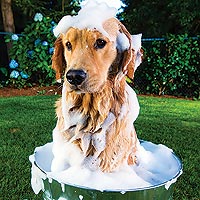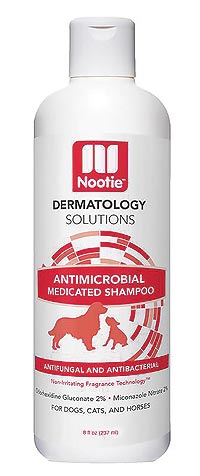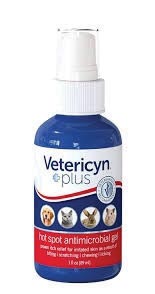Yeast infections in dogs are relatively common, but unless you’ve had first-hand experience, you might not identify the problem right away. In fact, many pet parents assume their canine companion has developed a constant “stinky dog smell,” when the problem is an overgrowth of yeast. A yeast infection can occur anywhere on a dog’s skin, including between the toes, in the armpits, and in deep skin wrinkles and folds. But the most common location is the ears. Yeast love damp, warm environments and thrive when the immune system becomes unbalanced.
How and Why Dogs Develop Yeast Infections
Yeast infections of the skin and ears in dogs are commonly caused by an organism called Malassezia pachydermatis. M pachydermatis is a “lipid-dependent” yeast that can become pathogenic, existing in excessive quantities on susceptible hosts and making them miserable.
Dogs with a balanced immune system have healthy levels of yeast that occur naturally on the body, including on the paws. However, dogs who have weakened immune systems or who are immunosuppressed can end up with an overgrowth of yeast, as can dogs with overactive immune systems that result in allergies.
Malassezia research shows the fungus also affects how the immune system responds. In some circumstances, the fungus activates a massive cellular and humoral immune response, provoking an immune system over-reaction, and in some cases, there’s an immunosuppressive effect.
Yeast infections often occur during or after antibiotic therapy because these drugs reduce the beneficial bacterial levels necessary to maintain healthy skin defenses. Other factors that predispose dogs to yeast infections are increased humidity, altered skin pH levels (which is why I don’t recommend oatmeal shampoos) and prolonged corticosteroid therapy. Yeast can also be a problem for pets who are immunosuppressed, which includes those with an immunoglobulin deficiency or Cushing’s disease, and those taking prescription steroids (e.g., prednisone).
Allergies trigger a systemic inflammatory cascade that creates intense itching, which can lead to secondary bacterial skin infections, typically treated with antibiotics. The more antibiotics a dog is given, the worse the yeast infection tends to be. Along with antibiotics and corticosteroids, chemotherapeutic agents can also lead to yeast infections.
Symptoms and Diagnosis of a Yeast Infection
Almost all dogs with an overgrowth of yeast are excessively, persistently itchy at the site of the infection. If it’s a problem with your dog’s paws or ears, for example, she won’t be able to leave them alone. Chronic butt scooting can also be a clue. The terrible itchy feeling leads to desperate scratching and chewing, which can result in significant self-induced trauma and pain.
Another thing most pet parents notice is the smell. Yeast has a very distinctive odor, which has been described as similar to moldy bread, cheese popcorn, or corn chips. In fact, some people refer to a yeast infection on a dog’s paws as Frito Feet. It’s a pungent, musty, unpleasant smell that at times can be overpowering.
Other signs of a yeast infection include areas of skin irritation, redness, and inflammation, especially in and around the ears, the toes and pads of the feet, the nasal, facial or other skin folds, the anus, armpits, neck, and sometimes around the tail base. There might also be scaly or oily skin, a greasy hair coat and/or hair loss. Sometimes in chronic, severe yeast infections there are raised scaly patches of skin, or darkened, thickened skin. There might also be a secondary bacterial infection or a foul-smelling yellow-green discharge from the ears. There can also be behavior changes caused by the itching and pain, including depression, loss of appetite, anxiety, and even aggression.
Definitive diagnosis of a yeast infection requires either cytology (looking at a skin swab under a microscope) or culturing (submitting a sterile swab of the skin to the lab where the cells are grown and identified on a petri dish). Most veterinarians prefer skin cytology to identify yeast overgrowth in dogs.
If there’s an ear infection, either diagnosed or suspected, it’s extremely important to know whether the eardrums are still intact before putting any liquids, gels, cleansers, or other medications down in the ears. If one or both eardrums have ruptured, putting products into the ear canals can damage the middle and inner ear.
Most dogs with a yeast infection have it in more than one spot. For example, they can have it on all four paws, both ears, and in some cases, over their entire body.
Effective Treatment of a Yeast Infection
The most important aspect of addressing any chronic yeast infection, regardless of its cause, involves changes to the diet. The nutrition your dog receives either supports his immune system to keep yeast growth under control, or it does the opposite and exacerbates a yeast overgrowth situation. Dogs with yeast need an “anti-yeast diet” that is anti-inflammatory and species-specific. I prefer to use a novel protein (a protein you haven’t fed before), low/no starch diet for 3 months.
I also recommend adding a few natural antifungal foods to the diet, for example, small amounts of fresh garlic (VERY small), thyme, parsley, and oregano to help reduce the level of yeast naturally. Adding fermented veggies to your dog’s meals can also be very beneficial, along with caprylic acid (found in coconut oil), which has anti-Malassezia properties. Curcumin has also shown promise in reducing yeast growth in several studies.
Probiotics can be very beneficial, as well as the herbs pau d’arco or berberine (the active component in goldenseal, barberry and Oregon grape root). A 2016 study found berberine kills yeast directly but can also be used with anti-fungal drugs to enhance their effects.
The more potent undecylenic acid, which is an organic unsaturated fatty acid can be beneficial in treating stubborn infections because it helps break down the yeast’s biofilm. Olive leaf extract contains oleuropein, a potent antifungal natural extract that can also help.
Natural Antifungal Baths and Rinses
For skin yeast infections in dogs, I recommend a natural antifungal shampoo. I typically use a tea tree oil shampoo, as research shows it’s helpful in reducing Malassezia on the body (never use an essential oil on your dog without diluting it first). You can bathe your dog as often as necessary, but once a week at a minimum. I don’t recommend using oatmeal-based shampoos for pets with allergies or yeast infections because they don’t do anything to assist in re-establishing a healthy skin microbiome.
I’ve seen excellent results in yeasty dogs with dietary adjustments and two to three baths a week, along with ear cleaning and foot soaks as necessary. Bathing your dog isn’t always an easy or convenient task, but it’s an inexpensive, safe, drug-free, and effective way to control yeast and keep him comfortable. I also recommend antifungal rinses and sprays (including colloidal silver, which studies show has considerable anti-fungal activity) in between disinfecting baths.
It’s important to remember these recommendations won’t produce results overnight. It takes time using any all-natural protocol to see improvement. If these easy, inexpensive solutions are effective at managing your dog’s yeast issues, I’d recommend you continue the starch-free, anti-inflammatory fresh food diet year-round to minimize your pet’s likelihood of recurring infections.
Dog-Friendly Walks/Hikes
in the Moab Area |
Corona Arch - Easy/Moderate. 1.3 Miles one way. Trailhead is 25 minute drive from Moab.
North on US-191 to Potash Road (Utah 279).
Mill Creek Pathway - Easy. 1.1 Miles. Little to no driving. Starts at the intersection of 100 South and 100 West,
a block off of Main Street.
Portal Overlook - Hard. 2.0 Miles one way. Trailhead is 20 minute drive from Moab.
North on US-191 to Potash Road (Utah 279).
Grandstaff Canyon - Moderate. 2.0 Miles one way. Trailhead is 10-minute drive from Moab.
North on US-191 to the River Road (Utah 128) |
|